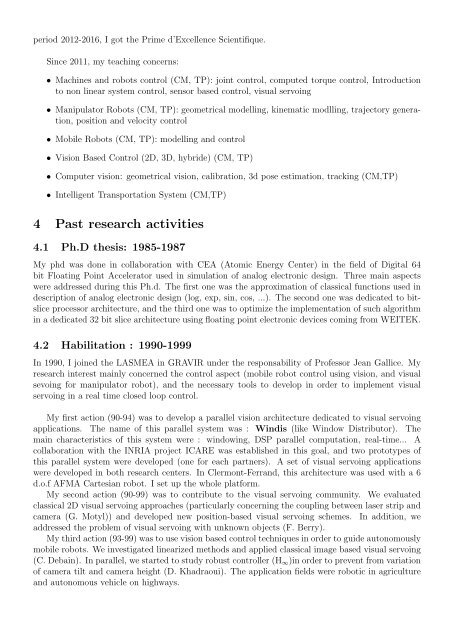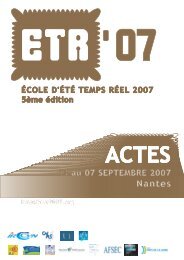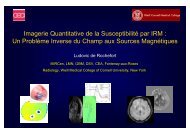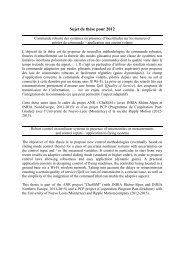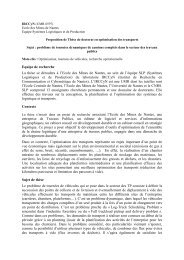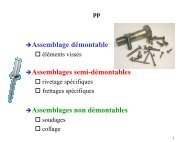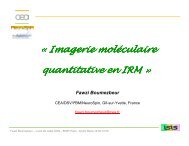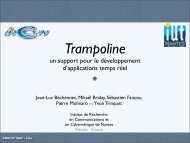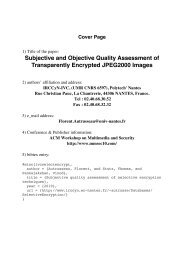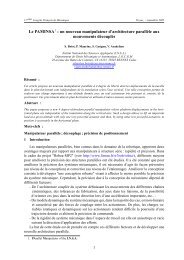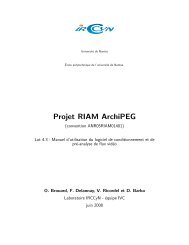Ecole Centrale of Nantes - IRCCyN
Ecole Centrale of Nantes - IRCCyN
Ecole Centrale of Nantes - IRCCyN
Create successful ePaper yourself
Turn your PDF publications into a flip-book with our unique Google optimized e-Paper software.
period 2012-2016, I got the Prime d’Excellence Scientifique.<br />
Since 2011, my teaching concerns:<br />
• Machines and robots control (CM, TP): joint control, computed torque control, Introduction<br />
to non linear system control, sensor based control, visual servoing<br />
• Manipulator Robots (CM, TP): geometrical modelling, kinematic modlling, trajectory generation,<br />
position and velocity control<br />
• Mobile Robots (CM, TP): modelling and control<br />
• Vision Based Control (2D, 3D, hybride) (CM, TP)<br />
• Computer vision: geometrical vision, calibration, 3d pose estimation, tracking (CM,TP)<br />
• Intelligent Transportation System (CM,TP)<br />
4 Past research activities<br />
4.1 Ph.D thesis: 1985-1987<br />
My phd was done in collaboration with CEA (Atomic Energy Center) in the field <strong>of</strong> Digital 64<br />
bit Floating Point Accelerator used in simulation <strong>of</strong> analog electronic design. Three main aspects<br />
were addressed during this Ph.d. The first one was the approximation <strong>of</strong> classical functions used in<br />
description <strong>of</strong> analog electronic design (log, exp, sin, cos, ...). The second one was dedicated to bitslice<br />
processor architecture, and the third one was to optimize the implementation <strong>of</strong> such algorithm<br />
in a dedicated 32 bit slice architecture using floating point electronic devices coming from WEITEK.<br />
4.2 Habilitation : 1990-1999<br />
In 1990, I joined the LASMEA in GRAVIR under the responsability <strong>of</strong> Pr<strong>of</strong>essor Jean Gallice. My<br />
research interest mainly concerned the control aspect (mobile robot control using vision, and visual<br />
sevoing for manipulator robot), and the necessary tools to develop in order to implement visual<br />
servoing in a real time closed loop control.<br />
My first action (90-94) was to develop a parallel vision architecture dedicated to visual servoing<br />
applications. The name <strong>of</strong> this parallel system was : Windis (like Window Distributor). The<br />
main characteristics <strong>of</strong> this system were : windowing, DSP parallel computation, real-time... A<br />
collaboration with the INRIA project ICARE was established in this goal, and two prototypes <strong>of</strong><br />
this parallel system were developed (one for each partners). A set <strong>of</strong> visual servoing applications<br />
were developed in both research centers. In Clermont-Ferrand, this architecture was used with a 6<br />
d.o.f AFMA Cartesian robot. I set up the whole platform.<br />
My second action (90-99) was to contribute to the visual servoing community. We evaluated<br />
classical 2D visual servoing approaches (particularly concerning the coupling between laser strip and<br />
camera (G. Motyl)) and developed new position-based visual servoing schemes. In addition, we<br />
addressed the problem <strong>of</strong> visual servoing with unknown objects (F. Berry).<br />
My third action (93-99) was to use vision based control techniques in order to guide autonomously<br />
mobile robots. We investigated linearized methods and applied classical image based visual servoing<br />
(C. Debain). In parallel, we started to study robust controller (H ∞ )in order to prevent from variation<br />
<strong>of</strong> camera tilt and camera height (D. Khadraoui). The application fields were robotic in agriculture<br />
and autonomous vehicle on highways.


